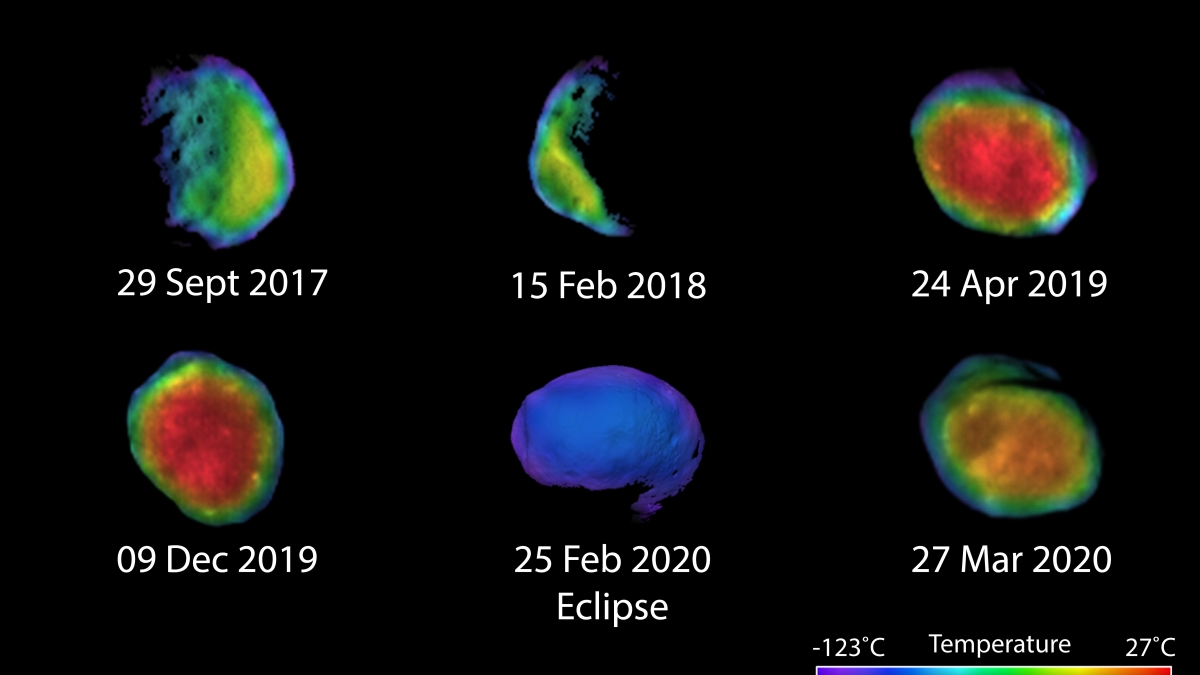ASU-led space instrument provides new views of Mars’ moon Phobos

Images of Mars’ moon Phobos, taken by the Mars Odyssey orbiter’s THEMIS instrument, colorized to show temperature variations and represent waxing, waning and full views of the moon. Credit: NASA JPL-Caltech
Three new views of the Martian moon Phobos have been captured by NASA's 2001 Mars Odyssey orbiter. Taken this past winter and this spring, they capture the moon as it drifts in and out of Mars' shadow. It's eclipse season on Mars, a six-month period which occurs twice each Mars year (the equivalent of two Earth years), which provides a unique opportunity to observe Phobos.
The orbiter's infrared camera, the Thermal Emission Imaging System (THEMIS), has been used to measure temperature variations across the surface of Phobos. This camera was built and is operated at Arizona State University, led by principal investigator Philip Christensen of the School of Earth and Space Exploration.
“THEMIS has significantly advanced our knowledge of Mars over its 20-year lifetime, and it is very exciting to see that it is still making new discoveries and new contributions to planetary science and exploration,” Christensen said.
The variations measured by THEMIS provide insight into the composition and physical properties of the moon. Further study could help settle a debate over whether Phobos, which is about 16 miles (25 kilometers) across, is a captured asteroid or an ancient chunk of Mars that was blasted off the surface by an impact.
Led by NASA's Jet Propulsion Laboratory in Southern California, Mars Odyssey's mission is mostly dedicated to studying the Martian surface. But in recent years, a process has been developed to flip the spacecraft upside-down so it can point its camera at Phobos.
“Taking an image of Phobos requires about six weeks to plan,” said THEMIS research analyst Jonathon Hill. “Mars Odyssey has to be flipped around to point away from Mars, take the image, and then flip back to point at Mars. During this process it is impossible for our antenna to maintain a lock on Earth, so we lose communications until the process is complete.”
Among the three new images, the one taken Dec. 9, 2019, shows Phobos in full-moon phase, when more of the surface is exposed to sunlight, with a maximum temperature of 81 degrees Fahrenheit (27 degrees Celsius). An image taken Feb. 25, 2020, shows Phobos while in eclipse, where Mars' shadow completely blocked sunlight from reaching the moon's surface. This provided some of the coldest temperatures measured on Phobos to date, with the lowest being about minus 189 degrees Fahrenheit (minus 123 degrees Celsius). On March 27, 2020, Phobos was observed exiting an eclipse, when the surface was still warming up.
All of the THEMIS infrared images are colorized to show temperature variations and are overlain on THEMIS visible images taken at the same time to show the geology of the surface. The one exception is the eclipse image, which is overlain on a computer-generated image to show what Phobos would have looked like if it wasn’t in complete shadow.
Combined with three previous images, these observations represent waxing, waning and full views of the moon. The Mars Odyssey team plans to observe crescent phases in coming months, providing a comprehensive view of how Phobos' surface warms and cools as it rotates.
"We're seeing that the surface of Phobos is relatively uniform and made up of very fine-grained materials," said Christopher Edwards of Northern Arizona University, who leads the processing and analysis of the Phobos images. "These observations are also helping to characterize the composition of Phobos. Future observations will provide a more complete picture of the temperature extremes on the moon's surface."
Mars Odyssey has been orbiting Mars since 2001. It takes thousands of images of the Martian surface each month, many of which help scientists select landing sites for future missions.
“Mars Odyssey and THEMIS teams have adapted and evolved so that we're still collecting unique data even after almost 19 years at Mars,” Hill said.
One of the sites Mars Odyssey captured pictures of is Jezero Crater, the landing site for NASA's Perseverance rover, which launches to Mars this summer and will include a camera system called Mastcam-Z, developed and operated by scientists at ASU and led by instrument principal investigator Jim Bell.
Mars Odyssey also serves an important role relaying commands and data for Mars' newest inhabitant, NASA's InSight lander and will pave the way for future missions like the Japan Aerospace Exploration Agency (JAXA) Martian Moon eXploration (MMX) mission, which will collect samples of Phobos in 2025.
“The THEMIS data will tell us the average size of the rocks and dust on Phobos' surface, which could be helpful to the MMX mission when they are preparing to collect their samples,” Hill said.
The prime contractor for the Mars Odyssey project, Lockheed Martin Space in Denver, developed and built the orbiter. Mission operations are conducted jointly from Lockheed Martin and from JPL, a division of Caltech in Pasadena.
More Science and technology

James Webb Space Telescope opens new window into hidden world of dark matter
NASA’s James Webb Space Telescope (JWST) has revealed unparalleled details about the early universe: observations of young…

US Department of Energy selects ASU and DCX to pioneer new ways to power data centers
The U.S. Department of Energy has selected Arizona State University and DCX USA, LLC, as key research partners for its…

From the lab to your headphones, new podcast brings ASU research to you
What do you get when an evolutionary biologist, an engineer and an anthropologist walk into a recording studio?At Arizona State…